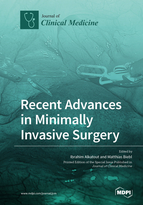Recent Advances in Minimally Invasive Surgery
A special issue of Journal of Clinical Medicine (ISSN 2077-0383). This special issue belongs to the section "Oncology".
Deadline for manuscript submissions: closed (30 December 2020) | Viewed by 111947
Special Issue Editors
Interests: surgical oncology; upper GI cancer; esophageal cancer; gastric cancer; clinical trials; minimally invasive surgery; robotic surgery
Special Issues, Collections and Topics in MDPI journals
Interests: gynecological oncology; endometriosis; surgical education; surgical training; urogynecology; neuropelveology; vNOTES; robotic surgery; minimally invasive surgery
Special Issue Information
Dear Colleagues,
Minimally invasive surgery has become a common term in visceral as well as gynecologic surgery. Though it first started as an exerimental option for single procedures, it has since evolved almost into its own surgical speciality over the past 20 years. Today, being firmly established in every subspeciality of visceral surgery, it is now no longer a distinct skillset, but a fixed part of the armamentarium of surgical options available. On this journey, the continuing evolution of the technical equipment enabled minimally-invasive surgery to grow from a distinct technique applicable to operative interventions of low and mid-technical difficulty to reach highly complex operative fields, especially oncologic surgery. In every indication, the advantages of a minimally invasive approach include reduced intraoperative blood loss, less postoperative pain, and shorter rehabilitation times, as well as a marked reduction of overall and surgical postoperative morbidity. In the advent of modern oncologic treatment algorithms, these effects not only lower the immediate impact an operation has on the patient, but also become important key steps in reducing the side-effects of surgery. Thus, they enable surgery to become a module in modern multi-disciplinary cancer treatment, which blends into multimodular treatment at different times and prolongs and widens the treatment possibilities available to cancer patients. Also, minimally invasive surgery has been the motor of surgical innovation throughout the past decade, and different surgical approaches, techniques of tissue handling, and also information about tissue like live perfusion monitoring have evolved, enriched, and sometimes changed traditional knowledge about tissue management in surgery.
Lastly, the requirements to learn and refine not only open surgical but also different minimally invasive techniques on high levels deeply impact surgical training pathways. The integration of modern elearning tools, the ability as well as the need to adopt newly available techniques throughout a whole surgical career, and the availability of indefinite virtual training options will influence not only the training but also the definite skillset of modern surgeons in the field of gynecologic and visceral surgery.
With this Special Issue, the up-to-date status of the role of minimally invasive surgery in both gynecology and visceral surgery is presented.
Prof. Dr. Matthias Biebl
Prof. Ibrahim Alkatout
Guest Editors
Manuscript Submission Information
Manuscripts should be submitted online at www.mdpi.com by registering and logging in to this website. Once you are registered, click here to go to the submission form. Manuscripts can be submitted until the deadline. All submissions that pass pre-check are peer-reviewed. Accepted papers will be published continuously in the journal (as soon as accepted) and will be listed together on the special issue website. Research articles, review articles as well as short communications are invited. For planned papers, a title and short abstract (about 100 words) can be sent to the Editorial Office for announcement on this website.
Submitted manuscripts should not have been published previously, nor be under consideration for publication elsewhere (except conference proceedings papers). All manuscripts are thoroughly refereed through a single-blind peer-review process. A guide for authors and other relevant information for submission of manuscripts is available on the Instructions for Authors page. Journal of Clinical Medicine is an international peer-reviewed open access semimonthly journal published by MDPI.
Please visit the Instructions for Authors page before submitting a manuscript. The Article Processing Charge (APC) for publication in this open access journal is 2600 CHF (Swiss Francs). Submitted papers should be well formatted and use good English. Authors may use MDPI's English editing service prior to publication or during author revisions.
Keywords
- Minimally invasive surgery
- Laparoscopic surgery
- Robotic surgery
- Minimally invasive oncologic surgery
- Surgical training







